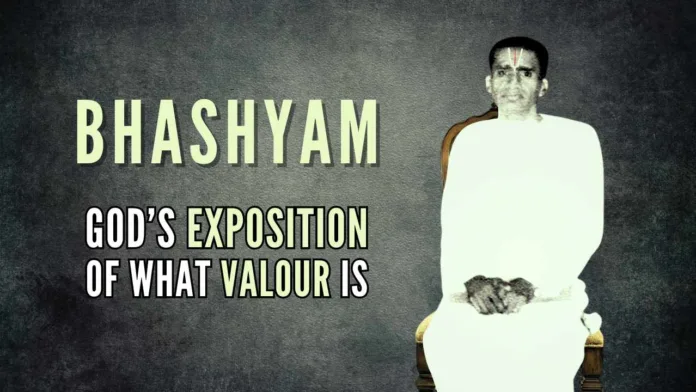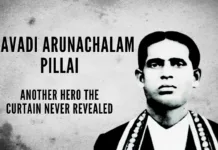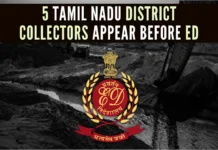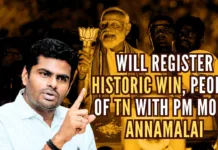
Remembering Arya Bhashyam, the unsung hero of freedom movement
The term Bhashyam means exposition or commentary. True to this, Sri. Bhashyam @ Arya’s is a story of raw courage propelled by his love for Bharata Mata and the urge to contribute to breaking her shackles and freeing her from the invaders’ occupation. He probably is Narayana’s exposition of what valour is and should be.
Erukattur is a sleepy village in the Tiruvarur district today with approximately a thousand people. When Sri Kuppuswami Ayyangar and Smt Shenbaga Lakshmi Amma lived there in the late 1800s and the early 1900s, Erukattur must have been an even smaller village of a few hundred people. Bhashyam was born on January 26, 1907, as the fifth child of Sri Ayyangar and Smt Shenbaga Lakshmi Amma at Amma’s native village, Serangulam, near Mannargudi.
As a BA student of the National College, Trichy (1924-28), Bhashyam, along with another friend of his, Anantharam, resolved that only an armed revolution would help drive the British occupiers out. While Bhashyam and his friends were still contemplating the means of their fight, the Simon Commission visited India (1928-29). Bhashyam led a group of his college mates in a protest against the Simon Commission. Their loud sloganeering ensured they were sanctioned by the Principal of their college, Sri Saranathan. Bhashyam was levied a fine of five rupees. The fine stood between Bhashyam and his attending classes. He refused to pay up, saying he hadn’t done anything wrong and no one could sanction him for speaking about the state of his beloved motherland. Prof Saranathan didn’t want the standoff to continue and affect the student’s education. So he told them that while he doesn’t have the power to revoke his sanction, he will pay the fine amount and close the issue. Bhashyam flatly refused the offer, reiterating that he did not do anything wrong. He quit college instead, and that was curtains to his college life.
After quitting college, he started an organization called ‘Gentlemen Farmer’s League’ operating out of the Varusanadu Valley in the Theni district of today. He procured four guns from the French region of Pondicherry and started training people handling firearms. When Sir Norman Edward Marjoribanks, the acting Governor of Madras province, visited Chidambaram to lay the foundation stone for a public park, Bhashyam chalked out a plan to assassinate him. He was at the venue, ready with his pistol to take his target out. But something snapped in him, and he returned without executing his plan. In an interview later[1], he lamented that he lost his chance to become the second Vanchinathan of Bharata that day.
Bhashyam was attracted by Mahatma Gandhi’s ideas and joined the Congress Seva Dal in 1931[2]. He participated in the ‘Temperance Movement’ called for by Mahatma Gandhi, picketing Toddy shops in the Ice House area of Triplicane, Chennai. The Toddy shop owner and employees manhandled Bhashyam, toddy pots broken over his head and beaten up badly, but he continued his demonstration without caring about anything.
His exploits during the ‘Foreign clothing boycott movement’ were yet another revelation. He would visit shops in the George Town area in Chennai, selling foreign clothing carrying a bag of wet clothes with phosphorous packed inside. He would leave what he carried in a strategic location. Once sun dried the clothes, the phosphorous packed inside would catch fire gutting the shop that sold foreign clothing. As the shop went up in flames, Bhashyam and his friends sang songs about the national movement and the importance of being Swadeshi. Thinking of settling this foreign clothing issue, he set the Binny Mills godown in Armenian Street, Chennai, on fire. He soaked a long tail of clothes in kerosene, ignited it, and slowly pushed it through a gap in the warehouse window. The ensuing smoke alerted the security personnel in the warehouse who averted a major disaster by putting the fire off.
His Netaji Bose connection
Dada Amir Haider Khan was a revolutionary from the Rawalpindi district then united India. Bhashyam came in contact with Dada Amir, who was in Madras then under the nom de guerre, Shankar. Later, Dada Amir was betrayed by his friend and collaborator Purushottaman, who turned approver when the British police arrested him. As the case came to court, Purushottaman was supposed to testify against Dada Amir. Bhashyam threatened Purushottaman that he would murder him if he testified against Dada Amir. The CID cover ensured that Bhashyam was caught and incarcerated at the Madras Central Prison. Eventually, Data Amir was also sent to the Madras Central Prison after his case was over. In Madras Central Prison, Bhashyam and Dada Amir started an indefinite hunger strike stating three demands.
- Political prisoners should not be kept in solitary confinement.
- They shouldn’t be confined to their cells during the day.
- They should be served with an ample supply of diluted buttermilk to beat the heat[3].
Dada Amir became weak, and the British authorities decided to force-feed him through a rubber tube. Bhashyam, who was only allowed to leave his cell for bathing, saw the scene of Dada Amir being force-fed in the next cell. He pounced on the policemen doing it, threw them off, and started wrestling with them. More force was called for to subdue Bhashyam, who was later confined to the death row inmates section and treated to batons, rods, and boots. Netaji Subhas Chandra Bose, who was also in the same jail, got to know about this from the manager of the prison, who was a Parsi gentleman. Subhas Babu suggested to the jail authorities that they should defuse the situation by agreeing to the demands of the two revolutionaries. Subhas Babu highlighted the case of another revolutionary from Anusheelan Samithi, Jatindra Nath Das, who passed away in the Lahore Central Jail on the 63rd day of his indefinite hunger strike[4]. The authorities decided to accede to the demands of the two revolutionaries and their indefinite hunger strike ended with Subhas Babu giving a glass of fruit juice to Bhashyam.
Bhashyam was later transferred to the Bellary (Karnataka) prison. Here, he saw Mahavir Singh, an associate of Bhagat Singh in the Lahore Conspiracy case, being badly flogged by the jail warden on the orders of an Anglo-Indian Jail Officer, Ince. Bhashyam took revenge by badly beating up Ince to the level that he lost consciousness. Bhashyam was later tied upside down and flogged and beaten badly as he happily sang the famous Bharatiyar song, Jayam Undu Bhayam Illai Maname (Victory is near. Why fear, my heart).
The Bhashyam the world should know
In 1930, the Congress party (the real one of those days) declared January 26 as the Poorna Swaraj Diwas in their Lahore Session. It urged all Bharatiyas to celebrate this day as Independence Day. As part of the Independence Day celebrations, the Congress, in 1932, asked all Bharatiyas to raise the Swaraja flag at their home[5]. Bhashyam wanted to do something special, something the British occupiers would never forget. He was in Triplicane, Madras then at his elder brother, Chakravarthy Iyengar’s house. Bhashyam took his friend Venugopal for a second show of an English movie at the Elphinstone Theatre in Mount Road, Madras[6]. This is the theatre where the English who worked in Fort St. George, the seat of British power, came to entertain themselves. Only the two knew that Bhashyam carried a huge, handmade Swarajya flag beneath his vest[7]. With Venugopal being the minder, to ensure no one got suspicious, Bhashyam tactfully infiltrated among the crowd of Fort St. George employees and quietly walked into the Fort premises. The wireless station housed two towers. One was a 140 feet high and 3 feet wide flag mast. This lone man scaled 140 feet in the quiet of the night, only punctuated by the chilly beach winds and the momentary streak of light from the revolving light atop the nearby lighthouse. Using a small knife he carried, he cut the Union Jack and released it to disappear in the dark. He carefully tied and hoisted the Swaraja flag he had made and carried and slowly climbed down. He slipped away without getting noticed. The Madras of January 26, 1932, woke up to the pleasant shock of a huge Swaraja flag fluttering atop Fort St. George, the seat of British power in South India. The furious authorities were clueless and flummoxed. It took till late afternoon before they recovered and could get a replacement Union Jack. You can say that this was revenge that Bhashyam extracted, avenging the killing of the young Tirupur Kumaran[8], who was canned to death trying to protect a Swaraja flag from being desecrated by the British. This was in Tirupur on January 11, 1932, just 15 days before another youngster, the Lion called Bhashyam hoisted the Swaraja flag right atop the British seat of power.
Bhashyam, the painter and sculptor
Bhashyam was also a great painter and sculptor par excellence. Here is a short list of his works.
- Chief Minister K Kamarajar commissioned Bhashyam to make a prototype of the Mahatma Gandhi bust to be kept on tables in government offices in Tamil Nadu.
- Mahatma Gandhi statues at the Dakshin Bharat Hindi Prachar Sabha in Chennai and also in Takkar Baba Vidhyalaya in Venkatanarayana Road in T Nagar, Chennai.
- The statue of Dheerar S Satyamurti, a freedom fighter and politician who was also the Mayor of Madras. He is also remembered as the mentor of K Kamarajar, who later became the chief minister of Tamil Nadu. This statue stands outside the Rippon Building, the seat of the Chennai Corporation.
- The statue of Thyagi Vaidhyanatha Iyer in Madurai. Vaidhyanadha Iyer, a freedom fighter, was also the champion of the Temple Entry Movement that ensured entry to the temple for people belonging to backward and marginalized communities.
- One of his most famous paintings is of Mahakavi Bharatiyar for his Kuyil Pattu (Song of the Koel)
There is a very famous Mahakavi Bharatiyar song about the fire of freedom in which a part goes like this.
“Will the one yearning for freedom be satisfied with anything else?Like the one who is famished never thinks of wine.
I praise thee, Mother. Vande Mataram is my only Mantra”
வீர சுதந்திரம் வேண்டி நின்றார் பின்னர்
வேறொன்று கொள்வாரோ? என்றும்
ஆரமுது உண்ணுதற்க்கு ஆசை கொண்டார்
கள்ளில் அறிவைச் செலுத்துவாரோ?
வந்தே மாதரம் ஒன்றே தாரகம்
Like this song, many great sons and daughters of the soil wanted nothing but freedom and sacrificed their present for the future of Bharata. Let us remember and walk the path they paved to make Bharata the great country it was before the advent of the occupiers from the outside.
Notes:
[1] In an interview for AIR, Chennai, with the writer Akhilan on September 20, 1971
[2] Seva Dal is a front organisation of Congress started in 1923 by Dr Narayan Subbarao Hardikar. Hardikar formed a local organisation in Hubli called Hubli Seva Mandal. The work of this small organisation was thought worth being emulated on a larger scale, and thus came to the idea of forming a pan-India organisation called Hindustani Seva Mandal (HSM) in 1923. HSM was rechristened as Seva Dal later
[3] Diluted buttermilk or Neer Mor (Tamil) is a traditional thirst quencher during summers. With or without condiments, this is an all-time favourite of Tamils, rich or poor
[4] Subhash Chandra Bose personally received the mortal remains of Jatindra Nath Bose when it came to Calcutta from Lahore in a train. He also led a procession from the Howrah Railway Station to the cremation ground
[5] The Swarajya flag was a tricolour flag similar to our national flag of today. The only difference is the center of the flag, where you had a charkha or a spinning wheel as opposed to the Ashoka Chakra of today
[6] Venugopala Sarma was the nephew of another great son of Bharata, the selfless freedom fighter, Subramania Sivam. He was the son of Sivam’s younger sister, Smt. Gyanambal and Sri. Subramania Iyer.
[7] Bhashyam bought Khaddar white cloth and hand painted and stitched his Swarajya flag. He also wrote in big letters in the bottom part the following words, “From today, India breathes the air of freedom”
[8] Tirupur Kumaran was a revolutionary and freedom fighter. He was 27 years of age when he was beaten to death by British police during a protest march in Tirupur. He died trying to save a Swaraja flag from being desecrated by the British. So he is famously called “Kodi Kaaththa Kumaran” or “Kumaran, who saved the flag.” Unfortunately, he is one of the less known and lesser celebrated freedom fighters of Bharat (like many others)
Viduthalai Veerar Bhashyam Arya, Authored by Aariyaththamizhan (Tamil, Bharati Noolagam, 2022)
Note:
1. Text in Blue points to additional data on the topic.
2. The views expressed here are those of the author and do not necessarily represent or reflect the views of PGurus.
For all the latest updates, download PGurus App.
- Chavadi Arunachalam Pillai – Another hero the curtain never revealed - April 27, 2024
- Was Ambedkar anti-Hindu? - April 14, 2024
- V. V. S. Aiyar – The ‘all-rounder’ Maharishi who gave it all for Bharat Mata - April 2, 2024










